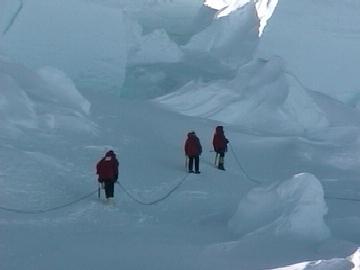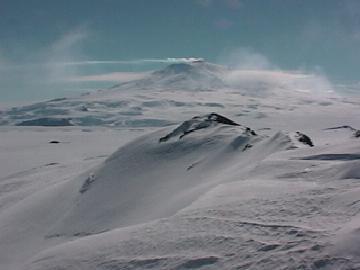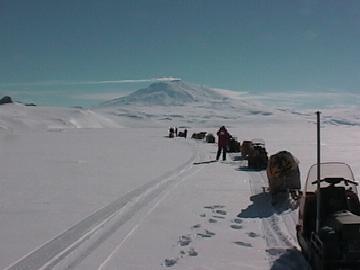26 November, 2002
Shakedown: Day 1
This day got off to an early start. I did a live web
cast with my students back home that started at
5:30AM, here. It was a real treat for me to get to
hear my students voices and I really enjoyed it when I
heard them get on just to say "hi" or to tell me news,
like my window was broken in the classroom. My
substitute thinks it's the work of a disgruntled
geology student with whom I left too many notes.
The rest of us needed to be ready by 7:30AM to start
loading gear into a truck to bring to the ice edge.
This isn't glorified car camping. This means bringing
tents, sleds, food boxes, climbing equipment and a
host of personal items about a half mile to the sea
ice and the ski-doos.
Once at the edge we learned the art of loading a sled
so that it doesn't tip easily. These sleds are large
and designed to be pulled by a strong little ski-doo,
but it really gives one appreciation for the work the
early Antarctic explorers did towing sleds much like
these with dogs or by themselves.
John Schutt gave us many pointers on traveling by
caravan and we made our way slowly toward our
destination. About an hour into the traverse, we
stopped at "Castle Rock," A large black rock sticking
right out of the snow. Being from "Castle Rock, CO"
I wanted to compare and contrast this with the one
back home. While the Castle Rock I know from home is
a conglomerate sandstone about 35 million years old,
this one is probably only a few thousand of years old
and is made of a rock called Hyaloclastite. This
igneous rock forms quickly when magma comes in contact
with ice. It's not too hard to picture this event in
this environment.
Speaking of volcanism, as our ski-doos rounded the
corner outside of Scott Base, the New Zealand base
adjacent to McMurdo, I caught a view of Mt. Erebus,
the southernmost active volcano in the world. A plume
of steam was rising from the top producing a long thin
cloud against a crystal clear blue sky. This day was
cool, but comfortable, and by afternoon, down right
warm, with all of us wearing our gear.
We set up camp on the flanks of the volcano, on the
Erebus glacier tongue that extends from the volcano to
McMurdo Sound and the Ross Ice Shelf. From this
elevation, one can see for hundreds of miles. The
Ross Ice Shelf is the size of Texas, and full of
trapped icebergs and pressure ridges. But from here
it looks as flat as a calm sea.
After camp was set up, we went to a crevasse area and
learned the basics of roping up and crevasse rescue.
Jamie Pierce and John Schutt are really gifted
teachers. They went at a pace that was helpful, and
gave us practical experience. But mostly they made it
fun with their personalities and stories. We learned
everything from how to set up an anchor in the snow,
to how to set up a pulley system to raise a victim
from a crevasse.
I think my favorite part of the day was when we roped
up and walked through a field of crevasses and
serracs, large chunks of falling glacial ice. At one
point, Jaime disappeared into the crevasse on purpose,
forcing his team to orchestrate a rescue. I couldn't
stop laughing because he looked so funny going over
the edge.
It was getting pretty late, but it was such a nice
evening (and the sun never sets), so we gave the
ski-doos a real shakedown at a place John calls the
wall of death. One plunges their snow machine down an
embankment and right up a steep wall that underlies a
cornice. Then races up the other side, hoping to
"catch a little air."
It was time for team photos with the volcano, and
finally, supper, around 10:00PM. We all varied how we
slept, but I could not have slept better. This
experience really gives me confidence for the expedition.

All roped up for crevasse training.

Mt. Erebus from Castle Rock.

Mt. Erebus from our caravan of Ski-doos.

Mr. C doing his best Darth Vader impression.
Contact the TEA in the field at
.
If you cannot connect through your browser, copy the
TEA's e-mail address in the "To:" line of
your favorite e-mail package.
|
